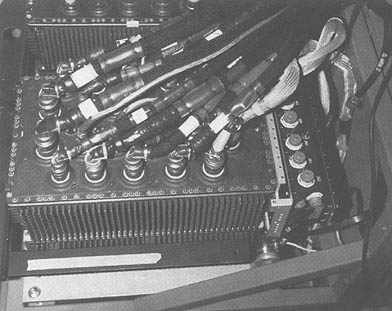From NASA's Software Catalog
Excerpt from catalog cover letter
From the rudimentary but effective Apollo Guidance and Navigation System that landed the first humans on the lunar landscape to the 500,000 lines of code used to put the Mars Curiosity Rover on the surface of the Red Planet, software has always been at the core of NASA’s mission successes…The technologies featured in this catalog represent NASA’s best solutions to a wide array of complex problems, and they are on offer here to the public for use.
—David Lockney, the Technology Transfer Program Executive
 |
| caveat emptor |
This is an impressive list. According to the Press Release (14-102), "NASA is making available to the public, at no cost, more than 1,000 codes ..."
I am not sure what's meant by "codes." Could they mean source code? Could they mean libraries? Could they mean executables? One thing is certain, it's unlikely the release was written by someone who doesn't know much about software. I digress.
The catalog lists over 160 pages of software products. The products are organized into 15 categories including "Data Servers Processing and Handling," "Crew and life support," "Autonomous Systems," and "Vehicle Management" just to name a few. Some of the items look pretty interesting. Here's a sampling:
- Station/Orbiter Multibody Berthing/Docking Analysis Tool (SOMBAT).
U.S. Government Purpose Release, Page 109
Described as a "multibody dynamics and control system simulation tool." If this is anything like the DARTS/DSHELLproduct developed at JPL, there must be a lot of math in this package. I wonder if SOMBAT was ever used for flight. I wish I'd been at the team meetings where serious-minded engineers were gravely proclaiming the importance of SOMBAT. It's a perfect subject for Vi Hart. She sings about a Laserbat. Could there be a connection? (I strongly recommend viewing Vi Hart's marvelous Twelve Tones video. - Station Spacewalk Game App
General Public Release, Page 109
Described as simulations of Extravehicular Activities (EVAs) conducted by NASA astronauts on missions to the International Space Station. I really wanted to try this one out. To my disappointment, the game crashed two different browsers. Bummer. - Real-Time Kidney Stone Tracking Algorithm
U.S. Government Purpose Release, Page 116
Described an algorithm that uses focused ultrasound to clear stones from a kidney. The software is a component of the "Rolling Stones prototype;" i.e. you need the Rolling Stones software. (Not in the catalog.) I'd give this offering high marks for its low pun. - Rover Software (RoverSW), Version 1
Open Source Release, Page 116
Described as a modular, extensible framework for exploration robots. The core provides the for building a service-oriented architecture that uses middleware. Hard to believe this code has flown because 1) it's open source1 and 2) no current flight system, I know of, would waste the onboard cycles on middleware. One day. Still, I bet it is a fun research project and might be just be the thing for a graduate student project. - MAVEN Flight and Ground Software
U.S. Government Purpose Release, Page 116
Described as a flight/ground package. Here's some substance. The products include simulation models, regression tests and even the flight code that runs on the spacecraft's flight processor. This is a proprietary product of Lockheed Martin Space Systems that's built on the technology developed for JUNO and MRO. It may not be the latest technology, but it's the real deal. I wonder what would happen if SpaceX wanted to license it.
Here's the description of the release categories from from the catalog:
- General Public Release—For codes with a broad release and no nondisclosure or export control restrictions
- Open Source Release—For collaborative efforts in which programmers improve upon codes originally developed by NASA and share the changes
- U.S. Release Only—For codes available to U.S. persons only, with no further transfer of the software allowed without the prior written approval of NASA
- U.S. and Foreign Release—For codes that are available to U.S. persons and (under special circumstances)persons outside of the U.S.
- U.S. Government Purpose Release—For codes that are to be used on behalf of the U.S. government
- Project Release—For use under a contract, grant, or agreement
- Interagency Release—For use by U.S. government agencies
- NASA Release—For use only by NASA personnel and contractors
- Items categorized as General Public Release: 27 (3%)
- Items categorized as Open Source Release: 111 (11%)
- Items categorized as U.S. Release Only: 213 (22%)
- Items categorized as U.S. and Foreign Release: 22 (2%)
- Items categorized as U.S. Government Purpose Release: 590 (61%)
- Combined total of the above: 963
 |
| NASA Press Release (14-102) |
It's worth noting that under Title 37, any software developed with government funds is available for free, under a Government Use License, to any business or institution doing government business.3 After all, the government doesn't want to pay to develop the same product twice.
More interesting perhaps is the NASA software that is not listed in the catalog. The excluded software should also be available under a government use license. Take for example, the software on the Mars Opportunity Rover; it is not in the catalog. Isn't that ironic since, the Opportunity software is featured in the catalog's cover letter written by the Technology Transfer Executive?4 (see the excerpt at the top of this posting.)
So let's say you find some software in the catalog that you want. Here's a few things to bear in mind:
- This is not commercial software. The software has probably not been "packaged" for use by a 3rd-party user. i.e. there may not be sufficient information about installation or use. (Not for lack of professionalism on the part of the development team.)
- The software may not be immediately available. Someone may have to tar it up and do a bit of head scratching to decide what's in the package. Budgets are limited and the engineer who does the packaging may do the work on their own time.
- Many of the items are "research grade." The software is the product of talented domain experts who work with limited requirements and have little or no budget for independent testing.
- Technical support may be iffy. If you need support or bug fixes, you will probably have to sign a NASA Space Act Agreement in order to transfer funds to NASA to pay the engineers who would provide support. (No fun here.)
- Don't expect a dedicated programming team. NASA funding is quixotic. Engineers have to move from project to project and task to task to stay employed
- Your needs may not be a priority. First dibs on engineering time will always go to mission needs. Unless you have management connections, you may be paying to bring a new developer up to speed or the response may not be timely.
- Don't count on getting an exclusive license for government projects. The law mandates that NASA must provide the software to anyone doing government work.
- As a rule, software that's been on a mission has been subjected to much more testing that non-mission software. However, this is no guarantee of quality.
- Some of the items in the catalog are decades old. The code may be very brittle.
So, before deciding to bet you project on a free NASA product, here's a few questions you might ask:
- Is the code under maintenance? What is the annual maintenance budget? (NASA budgets are not secret)
- Is there customer support? Who do I need to contract with to get the service?
- What's the bug reporting and repair cycle? How do I figure the cost of bug repair?
- How often are new versions released? How are patches handled; are they coupled with system-wide releases?
- Are the original developers still available?
- Are there any restrictions on the licensing? Can the license be exclusive?
- Was the software used on a mission?
- Is there a replacement product in the works?
- What kind of documentation is available?
- Is there a user community?
- Are there export restrictions (ITAR or EAR) of any kind?
NASA has a charter obligation to see that its "products and processes...benefit the lives of ordinary Americans and the U.S. economy." This make sense. It's good idea to get the maximum benefit from a government investment.
However, is the oversell necessary? At times it seems that excellence in engineering been replaced by excellence in public relations. At the very least, the catalog reflects an ignorance about software. After all, software is not like a hardware piece-part that still has value after sitting on the shelf a few years. Software only maintains its value if there's a team actively working on the product. If funding for the product is cut, the product dies. If that filter were applied, the catalog might have a hundred items instead of a thousand.
Despite the fact that "software has always been at the core of NASA’s mission successes," NASA does not act like it is in the software business. If it did, the NASA culture would be radically different.
It could be otherwise you know.
1. The International Tariff in Arms Regulations (ITAR), prohibits NASA from distribution flight software without careful review by the State Department. Foreign licensees of flight software must obtain a export license and make regular reports about protective measures to the state department. Not fun.
2. The figures in the list were obtained by doing a case-sensitive search of the catalog for the text of each restriction type. e.g. a search of "Open Source" produced 112 instances including 1 instance in the text. The total may be low because the naming of the restrictions is inconsistent. e.g. not all items include the word "release" i.e. "General Public" may be used instead of "General Public Release." While not exact, the figures are indicative.
3. See Title 37: Patents, Trademarks, and Copyrights PART 404—LICENSING OF GOVERNMENT-OWNED INVENTIONS §404.4 Authority to grant licenses. Note: No license is required when sharing occurs for work that being done under the same task order.
4. Despite the Federal Law, the Curiosity software is closely held. I worked on one project where the MSL management would not permit sharing of the code with a development team doing work under the same task order. I addressed the reasons for this in a previous posting: Sharing is no panacea.






